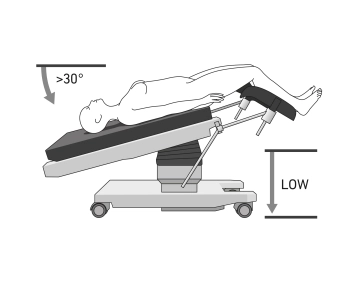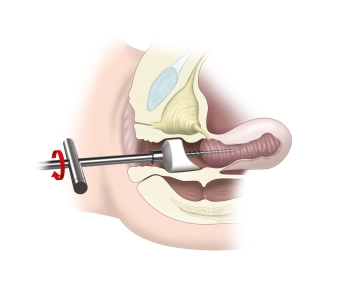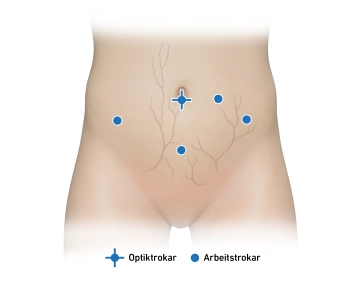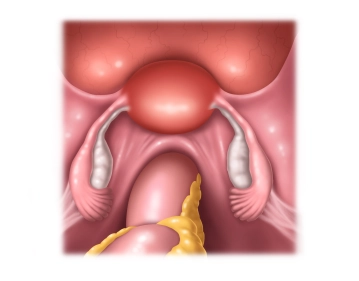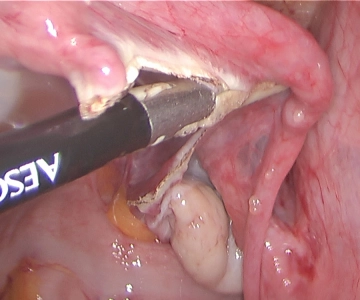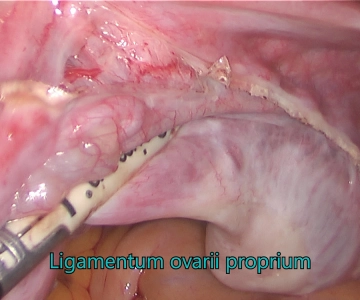- positioned in lithotomy position
- It is recommended to position both arms alongside the body (caution: use cotton wrapping when positioning with a cloth sling), or to position one arm on the assistant's side
- The legs should be adjustable in flexion and extension via the operating table control
- if necessary, use shoulder supports to prevent the patient from slipping on the operating table
- Attachment of a cervical adapter, e.g., a Hohl's bell
-
Positioning
![Positioning 1]()
![Positioning 2]()
-
Establishment of capnoperitoneum and insertion of the optical trocar
-
Inspection of the abdomen
Soundsettings During laparoscopy, the inspection of the abdomen is performed, including the upper abdominal area, the diaphragmatic domes, the liver, the gallbladder, the stomach, and the omentum. Additionally, an inspection of the intestines and the peritoneum is conducted.
Subsequently, head-down positioning.
-
Working trocars and inspection of the pelvis
![Working trocars and inspection of the pelvis 1]()
![Working trocars and inspection of the pelvis 2]()
Soundsettings Placement of 2 additional 5 mm working trocars under direct vision.
The selection of the number and position of laparoscopic incisions is at the discretion of the surgeon and is based on their personal preferences as well as the specific requirements of the operation. Incisions are often chosen in the left and right lower abdomen or in the left lower and mid-abdomen (left periumbilical).
Procedure for incisions in the lower abdomen: Visualization of the inferior epigastric artery in the lateral umbilical fold. Laterally, the superficial vessels are visualized through diaphanoscopy (superficial circumflex iliac artery, superficial epigastric artery). Two fingerbreadths medial to the anterior superior iliac spine, in the vessel-free area, incision and insertion of a working trocar into the lower abdomen.
Procedure for incisions in the mid-abdomen (mostly left): Visualization of the inferior epigastric artery in the lateral umbilical fold. The superficial vessels are visualized through diaphanoscopy. Incision at the level of the navel and approximately 3 cm lateral to it. It is important to ensure that the incision is not too close to the optical trocar or in line with the working trocar of the lower abdomen, to avoid collision risk.
Procedure for suprapubic incisions: Preoperative placement of a urinary catheter to empty the bladder. 1-2 fingerbreadths above the symphysis, the superficial vessels are visualized through diaphanoscopy. Incision and insertion of the working trocar under direct vision.
Inspection of the pelvis, considering the uterus, both adnexa, the Douglas pouch, and the transperitoneal visualization of both ureters.
-
Right salpingectomy
![Right salpingectomy]()
Soundsettings Grasp the distal part of the uterine tube and luxate it to better display the fimbrial funnel and the mesosalpinx. The uterus is mobilized to the left using the portio adapter to tension the structures in the area of the right pelvic wall. In the mesosalpinx, anastomoses of the tubal branch of the uterine artery and the tubal branches of the ovarian artery run. In the distal part, just before the fimbrial funnel, there is often a somewhat larger anastomosis. Bipolar coagulation in this area and then stepwise detachment of the tube from the right pelvic wall using scissors (or as in this video using Caiman, a bipolar vessel sealing instrument) while carefully sparing the right ovary. Bipolar coagulation of the tube in the course near the uterus and transection.
Depending on the operator's preference and the size of the findings, the uterine tube can be placed in a retrieval bag after detachment and retrieved through an incision extension from the left lower entry point. In the case of delicate tubes with unremarkable findings, e.g., in the context of sterilization, the tubes can be pulled out through the working trocar.
-
Left salpingectomy
-
Vascular mesometrium and broad ligament on the right
![Vascular mesometrium and broad ligament on the right 1]()
![Vascular mesometrium and broad ligament on the right 2]()
Soundsettings Representation of the ligamentum ovarii proprium. Here runs the ramus ovaricus of the arteria ovarica. Bipolar coagulation and transection.
Note: In practice, it has been shown to coagulate the ligamentum ovarii proprium at 2-3 points.
Bipolar coagulation of the ligamentum teres uteri (round ligament) and transection. Further stepwise transection of the peritoneal sheet of the ligamentum latum up to the bladder reflection.
Note: The ligamentum teres uteri should not be cut too close to the uterus, as there is a risk of bleeding, and additionally, the stump can serve for mobilization of the uterus. This is important in large uteri.
In this case, we have a large anterior wall myoma, which must first be mobilized. For this, opening of the bladder peritoneum and pushing caudally.
Here, strict attention is paid to the course of the ureter.
Same procedure as on the right. ... - Operations in general, visceral and transplant surgery, vascu
Activate now and continue learning straight away.
Single Access
Activation of this course for 3 days.
Most popular offer
webop - Savings Flex
Combine our learning modules flexibly and save up to 50%.
US$51.56/ yearly payment
gynecology
Unlock all courses in this module.
US$103.10 / yearly payment


